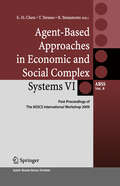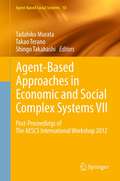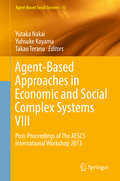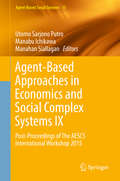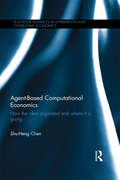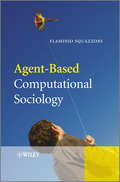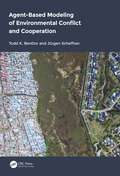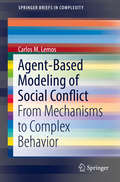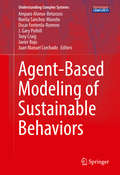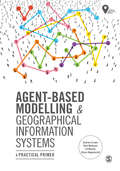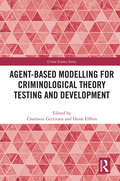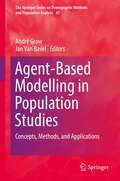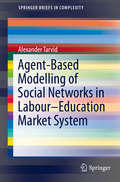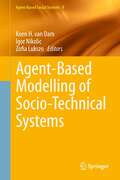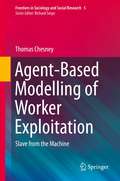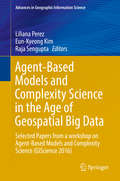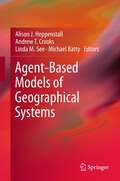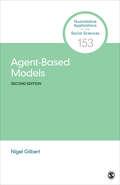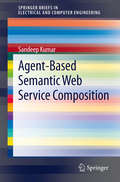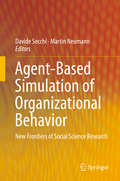- Table View
- List View
Agent-Based Approaches in Economic and Social Complex Systems VI: Post-Proceedings of The AESCS International Workshop 2009 (Agent-Based Social Systems #8)
by Takao Terano Ryuichi Yamamoto Shu-Heng ChenAgent-based modeling/simulation is an emergent approach to the analysis of social and economic systems. It provides a bottom-up experimental method to be applied to social sciences such as economics, management, sociology, and politics as well as some engineering fields dealing with social activities. This book includes selected papers presented at the Sixth International Workshop on Agent-Based Approaches in Economic and Social Complex Systems held in Taipei in 2009. We have 39 presentations in the conference, and 14 papers are selected to be included in this volume. These 14 papers are then grouped into six parts: Agent-based financial markets; Financial forecasting and investment; Cognitive modeling of agents; Complexity and policy analysis; Agent-based modeling of good societies; and Miscellany. The research presented here shows the state of the art in this rapidly growing field.
Agent-Based Approaches in Economic and Social Complex Systems VII: Post-Proceedings of The AESCS International Workshop 2012 (Agent-Based Social Systems #10)
by Takao Terano Shingo Takahashi Tadahiko MurataAgent-based modeling/simulation is an emergent approach to the analysis of social and economic systems. It provides a bottom-up experimental method to be applied to social sciences such as economics, management, sociology, and politics as well as some engineering fields dealing with social activities. This book includes selected papers presented at the Seventh International Workshop on Agent-Based Approaches in Economic and Social Complex Systems held in Osaka, Japan, in 2012. At the workshop, 24 reviewed full papers were presented, and of those, 17 were selected to be included in this volume. The papers are divided into two groups as "Fundamentals of Agent-Based Modeling" and "Applications of Agent-Based Modeling".
Agent-Based Approaches in Economic and Social Complex Systems VIII: Post-Proceedings of The AESCS International Workshop 2013 (Agent-Based Social Systems #13)
by Takao Terano Yutaka Nakai Yuhsuke KoyamaAgent-based modeling/simulation is an emergent approach to the analysis of social and economic systems. It provides a bottom-up experimental method to be applied to social sciences such as economics, management, sociology and politics as well as some engineering fields dealing with social activities. This book includes selected papers presented at the Eighth International Workshop on Agent-Based Approaches in Economic and Social Complex Systems held in Tokyo, Japan, in 2013. At the workshop, 23 reviewed full papers were presented and of those, 13 were selected to be included in this volume.
Agent-Based Approaches in Economics and Social Complex Systems IX: Post-Proceedings of The AESCS International Workshop 2015 (Agent-Based Social Systems #15)
by Utomo Sarjono Putro Manabu Ichikawa Manahan SiallaganThis book includes many cases that provide new perspectives in developing agent-based modeling and simulation. The real problems are complex, and sophisticated methodology is needed to handle them. Agent-based modeling and simulation is one methodology that provides a bottom-up experimental approach applicable to social sciences such as economics, management, sociology, and politics as well as some engineering fields dealing with social activities. However, to improve the applicability of agent-based modeling and simulation methods, a new perspective is needed. In this book, that new perspective is developed and utilized to deal with many cases of real-world problems such as the supply chain, land use and land cover, transportation, health, services, economics, and social problems. The cases are selected from papers presented at the Ninth International Workshop on Agent-Based Approaches in Economic and Social Complex Systems held in Bali, Indonesia, in 2015. At the workshop, 29 reviewed full papers were presented, and of those, 16 were selected to be included in this volume.
Agent-Based Computational Economics: How the idea originated and where it is going (Routledge Advances in Experimental and Computable Economics)
by Shu-Heng ChenThis book aims to answer two questions that are fundamental to the study of agent-based economic models: what is agent-based computational economics and why do we need agent-based economic modelling of economy? This book provides a review of the development of agent-based computational economics (ACE) from a perspective on how artificial economic agents are designed under the influences of complex sciences, experimental economics, artificial intelligence, evolutionary biology, psychology, anthropology and neuroscience. This book begins with a historical review of ACE by tracing its origins. From a modelling viewpoint, ACE brings truly decentralized procedures into market analysis, from a single market to the whole economy. This book also reviews how experimental economics and artificial intelligence have shaped the development of ACE. For the former, the book discusses how ACE models can be used to analyse the economic consequences of cognitive capacity, personality and cultural inheritance. For the latter, the book covers the various tools used to construct artificial adaptive agents, including reinforcement learning, fuzzy decision rules, neural networks, and evolutionary computation. This book will be of interest to graduate students researching computational economics, experimental economics, behavioural economics, and research methodology.
Agent-Based Computational Sociology
by Flaminio SquazzoniMost of the intriguing social phenomena of our time, such as international terrorism, social inequality, and urban ethnic segregation, are consequences of complex forms of agent interaction that are difficult to observe methodically and experimentally. This book looks at a new research stream that makes use of advanced computer simulation modelling techniques to spotlight agent interaction that allows us to explain the emergence of social patterns. It presents a method to pursue analytical sociology investigations that look at relevant social mechanisms in various empirical situations, such as markets, urban cities, and organisations. This book:Provides a comprehensive introduction to epistemological, theoretical and methodological features of agent-based modelling in sociology through various discussions and examples.Presents the pros and cons of using agent-based models in sociology.Explores agent-based models in combining quantitative and qualitative aspects, and micro- and macro levels of analysis.Looks at how to pose an agent-based research question, identifying the model building blocks, and how to validate simulation results.Features examples of agent-based models that look at crucial sociology issues.Supported by an accompanying website featuring data sets and code for the models included in the book. Agent-Based Computational Sociology is written in a common sociological language and features examples of models that look at all the traditional explanatory challenges of sociology. Researchers and graduate students involved in the field of agent-based modelling and computer simulation in areas such as social sciences, cognitive sciences and computer sciences will benefit from this book.
Agent-Based Modeling and Simulation with Swarm (Chapman & Hall/CRC Studies in Informatics Series)
by Hitoshi IbaSwarm-based multi-agent simulation leads to better modeling of tasks in biology, engineering, economics, art, and many other areas. It also facilitates an understanding of complicated phenomena that cannot be solved analytically. Agent-Based Modeling and Simulation with Swarm provides the methodology for a multi-agent-based modeling approach that i
Agent-Based Modeling of Environmental Conflict and Cooperation
by Jürgen Scheffran Todd BenDorConflict is a major facet of many environmental challenges of our time. However, growing conflict complexity makes it more difficult to identify win-win strategies for sustainable conflict resolution. Innovative methods are needed to help predict, understand, and resolve conflicts in cooperative ways.Agent-Based Modeling of Environmental Conflict and Cooperation examines computer modeling techniques as an important set of tools for assessing environmental and resource-based conflicts and, ultimately, for finding pathways to conflict resolution and cooperation. This book has two major goals. First, it argues that complexity science can be a unifying framework for professions engaged in conflict studies and resolution, including anthropology, law, management, peace studies, urban planning, and geography. Second, this book presents an innovative framework for approaching conflicts as complex adaptive systems by using many forms of environmental analysis, including system dynamics modeling, agent-based modeling, evolutionary game theory, viability theory, and network analysis. Known as VIABLE (Values and Investments from Agent-Based interaction and Learning in Environmental systems), this framework allows users to model advanced facets of conflicts—including institution building, coalition formation, adaptive learning, and the potential for future conflict—and conflict resolution based on the long-term viability of the actors’ strategies.Written for scholars, students, practitioners, and policy makers alike, this book offers readers an extensive introduction to environmental conflict research and resolution techniques. As the result of decades of research, the text presents a strong argument for conflict modeling and reviews the most popular and advanced techniques, including system dynamics modeling, agent-based modeling, and participatory modeling methods. This indispensable guide uses NetLogo, a widely used and free modeling software package, to implement the VIABLE modeling approach in three case study applications around the world. Readers are invited to explore, adapt, modify, and expand these models to conflicts they hope to better understand and resolve.
Agent-Based Modeling of Social Conflict: From Mechanisms to Complex Behavior (SpringerBriefs in Complexity)
by Carlos M. LemosThis Brief revisits and extends Epstein's classical agent-based model of civil violence by considering important mechanisms suggested by social conflict theories. Among them are: relative deprivation as generator of hardship, generalized vanishing of the risk perception ('massive fear loss') when the uprisings surpass a certain threshold, endogenous legitimacy feedback, and network influence effects represented by the mechanism of dispositional contagion. The model is explored in a set of computer experiments designed to provide insight on how mechanisms lead to increased complexity of the solutions. The results of the simulations are compared with statistical analyses of estimated size, duration and recurrence of large demonstrations and riots for eight African countries affected by the "Arab Spring," based on the Social Conflict Analysis Database. It is shown that the extensions to Epstein's model proposed herein lead to increased "generative capacity" of the agent-based model (i. e. a richer set of meaningful qualitative behaviors) as well the identification of key mechanisms and associated parameters with tipping points. The use of quantitative information (international indicators and statistical analyses of conflict events) allows the assessment of the plausibility of input parameter values and simulated results, and thus a better understanding of the model's strengths and limitations. The contributions of the present work for understanding how mechanisms of large scale conflict lead to complex behavior include a new form of the estimated arrest probability, a simple representation of political vs economic deprivation with a parameter which controls the `sensitivity' to value, endogenous legitimacy feedback, and the effect of network influences (due to small groups and "activists"). In addition, the analysis of the Social Conflict Analysis Database provided a quantitative description of the impact of the "Arab Spring" in several countries focused on complexity issues such as peaceful vs violent, spontaneous vs organized, and patterns of size, duration and recurrence of conflict events in this recent and important large-scale conflict process. This book will appeal to students and researchers working in these computational social science subfields.
Agent-Based Modeling of Sustainable Behaviors (Understanding Complex Systems)
by Juan Manuel Corchado Javier Bajo Amparo Alonso-Betanzos Noelia Sánchez-Maroño Oscar Fontenla-Romero J. Gary Polhill Tony CraigUsing the O. D. D. (Overview, Design concepts, Detail) protocol, this title explores the role of agent-based modeling in predicting the feasibility of various approaches to sustainability. The chapters incorporated in this volume consist of real case studies to illustrate the utility of agent-based modeling and complexity theory in discovering a path to more efficient and sustainable lifestyles. The topics covered within include: households' attitudes toward recycling, designing decision trees for representing sustainable behaviors, negotiation-based parking allocation, auction-based traffic signal control, and others. This selection of papers will be of interest to social scientists who wish to learn more about agent-based modeling as well as experts in the field of agent-based modeling.
Agent-Based Modelling and Geographical Information Systems: A Practical Primer (Spatial Analytics and GIS)
by Andrew Crooks Nick Malleson Dr Ed Manley Alison HeppenstallThis is the era of Big Data and computational social science. It is an era that requires tools which can do more than visualise data but also model the complex relation between data and human action, and interaction. Agent-Based Models (ABM) - computational models which simulate human action and interaction – do just that. This textbook explains how to design and build ABM and how to link the models to Geographical Information Systems. It guides you from the basics through to constructing more complex models which work with data and human behaviour in a spatial context. All of the fundamental concepts are explained and related to practical examples to facilitate learning (with models developed in NetLogo with all code examples available on the accompanying website). You will be able to use these models to develop your own applications and link, where appropriate, to Geographical Information Systems. All of the key ideas and methods are explained in detail: geographical modelling; an introduction to ABM; the fundamentals of Geographical Information Science; why ABM and GIS; using QGIS; designing and building an ABM; calibration and validation; modelling human behaviour; visualisation and 3D ABM; using Big Geosocial Data, GIS and ABM. An applied primer, that provides fundamental knowledge and practical skills, it will provide you with the skills to build and run your own models, and to begin your own research projects.
Agent-Based Modelling and Geographical Information Systems: A Practical Primer (Spatial Analytics and GIS)
by Andrew Crooks Nick Malleson Dr Ed Manley Alison HeppenstallThis is the era of Big Data and computational social science. It is an era that requires tools which can do more than visualise data but also model the complex relation between data and human action, and interaction. Agent-Based Models (ABM) - computational models which simulate human action and interaction – do just that. This textbook explains how to design and build ABM and how to link the models to Geographical Information Systems. It guides you from the basics through to constructing more complex models which work with data and human behaviour in a spatial context. All of the fundamental concepts are explained and related to practical examples to facilitate learning (with models developed in NetLogo with all code examples available on the accompanying website). You will be able to use these models to develop your own applications and link, where appropriate, to Geographical Information Systems. All of the key ideas and methods are explained in detail: geographical modelling; an introduction to ABM; the fundamentals of Geographical Information Science; why ABM and GIS; using QGIS; designing and building an ABM; calibration and validation; modelling human behaviour; visualisation and 3D ABM; using Big Geosocial Data, GIS and ABM. An applied primer, that provides fundamental knowledge and practical skills, it will provide you with the skills to build and run your own models, and to begin your own research projects.
Agent-Based Modelling for Criminological Theory Testing and Development (Crime Science Series)
by Charlotte GerritsenAgent-Based Modelling for Criminological Theory Testing and Development addresses the question whether and how we can use simulation methods in order to test criminological theories, and if they fail to be corroborated, how we can use simulation to mend and further develop theories. It is by no means immediately obvious how results being observed in an artificial environment have any relevance for what is going on in the real world. By using the concept of a "stylized fact," the contributors bridge the gap between artificial and real world. With backgrounds in criminology or artificial intelligence (AI), these contributors present agent-based model studies that test aspects of various theories, including crime pattern theory, guardianship in action theory, near repeat theory, routine activity theory, and general deterrence theory. All six simulation models presented have been specially developed for the book. Contributors have specified the theory, identified stylized facts, developed an agent-based simulation model, let it run, and interpreted whether the chosen stylized fact is occurring in their model, and what we should conclude from congruence or incongruence between simulation and expectations based on the theory under scrutiny. The final chapter discusses what can be learnt from these six enterprises. The book will be of great interest to scholars of criminology (in particular computational criminologists and theoretical criminologists) and AI (with an emphasis on AI for generative social processes), and more widely researchers in social science in general. It will also be valuable for master's courses in quantitative criminology.
Agent-Based Modelling in Economics
by Nigel Gilbert Lynne HamillAgent-based modelling in economics Lynne Hamill and Nigel Gilbert, Centre for Research in Social Simulation (CRESS), University of Surrey, UK New methods of economic modelling have been sought as a result of the global economic downturn in 2008.This unique book highlights the benefits of an agent-based modelling (ABM) approach. It demonstrates how ABM can easily handle complexity: heterogeneous people, households and firms interacting dynamically. Unlike traditional methods, ABM does not require people or firms to optimise or economic systems to reach equilibrium. ABM offers a way to link micro foundations directly to the macro situation. Key features: Introduces the concept of agent-based modelling and shows how it differs from existing approaches. Provides a theoretical and methodological rationale for using ABM in economics, along with practical advice on how to design and create the models. Each chapter starts with a short summary of the relevant economic theory and then shows how to apply ABM. Explores both topics covered in basic economics textbooks and current important policy themes; unemployment, exchange rates, banking and environmental issues. Describes the models in pseudocode, enabling the reader to develop programs in their chosen language. Supported by a website featuring the NetLogo models described in the book. Agent-based Modelling in Economics provides students and researchers with the skills to design, implement, and analyze agent-based models. Third year undergraduate, master and doctoral students, faculty and professional economists will find this book an invaluable resource.
Agent-Based Modelling in Population Studies: Concepts, Methods, and Applications (The Springer Series on Demographic Methods and Population Analysis #41)
by André Grow Jan Van BavelThis book examines the use of agent-based modelling (ABM) in population studies, from concepts to applications, best practices to future developments. It features papers written by leading experts in the field that will help readers to better understand the usefulness of ABM for forecasting, how ABM can be injected with empirical data to achieve a better match between model and reality, how geographic information can be fruitfully used in ABM, and how ABM results can effectively and correctly be reported in a concise way. Overall, coverage ranges from detailing methods of agent-based modelling to existing paradigms in population studies to infusing agent-based models with empirical data. The papers show the benefits that ABM offers the field, such as enhanced theory formation by better linking the micro-level with the macro-level, the ability to represent populations more adequately as complex systems, and a way that laboratories can study rare events and the implications of alternative mechanisms. In addition, readers will discover guidelines and best-practices with detailed examples of how to apply agent-based models in different areas of population research, including human mating behaviour, migration, and socio-structural determinants of health behaviours. This book collects papers from the workshop "Recent Developments and Future Directions in Agent-Based Modelling in Population Studies," which took place at the University of Leuven, Belgium in September 2014. It will contribute to the development of best-practices in the field and will provide a solid point of reference for scholars who want to start using agent-based modelling in their own research.
Agent-Based Modelling of Social Networks in Labour-Education Market System (SpringerBriefs in Complexity)
by Alexander TarvidThis book covers the modelling of human behaviour in the education and labour markets, which due to their interdependency are viewed as one system. Important factors influencing the decision-making of individuals and firms in this system are discussed. The role of social environment and networks is stressed. The approach of agent-based modelling is presented and compared with standard economic modelling and other simulation techniques in the context of modelling complex adaptive systems. Practical questions in building agent-based models of labour-education market system with social networks are discussed. These questions include modelling the structure of education system and agent behaviour there; modelling and calibrating the labour market without and with firms; generating the social network, defining its behaviour and calibrating it; and embedding the resulting system into a larger model.
Agent-Based Modelling of Socio-Technical Systems (Agent-Based Social Systems #9)
by Zofia Lukszo Koen H. Dam Igor NikolicDecision makers in large scale interconnected network systems require simulation models for decision support. The behaviour of these systems is determined by many actors, situated in a dynamic, multi-actor, multi-objective and multi-level environment. How can such systems be modelled and how can the socio-technical complexity be captured? Agent-based modelling is a proven approach to handle this challenge. This book provides a practical introduction to agent-based modelling of socio-technical systems, based on a methodology that has been developed at TU Delft and which has been deployed in a large number of case studies. The book consists of two parts: the first presents the background, theory and methodology as well as practical guidelines and procedures for building models. In the second part this theory is applied to a number of case studies, where for each model the development steps are presented extensively, preparing the reader for creating own models.
Agent-Based Modelling of Worker Exploitation: Slave from the Machine (Frontiers in Sociology and Social Research #5)
by Thomas ChesneyThis book illustrates the potential for computer simulation in the study of modern slavery and worker abuse, and by extension in all social issues. It lays out a philosophy of how agent-based modelling can be used in the social sciences. In addressing modern slavery, Chesney considers precarious work that is vulnerable to abuse, like sweat-shop labour and prostitution, and shows how agent modelling can be used to study, understand and fight abuse in these areas. He explores the philosophy, application and practice of agent modelling through the popular and free software NetLogo. This topical book is grounded in the technology needed to address the messy, chaotic, real world problems that humanity faces—in this case the serious problem of abuse at work—but equally in the social sciences which are needed to avoid the unintended consequences inherent to human responses. It includes a short but extensive NetLogo guide which readers can use to quickly learn this software and go on to develop complex models. This is an important book for students and researchers of computational social science and others interested in agent-based modelling.
Agent-Based Models and Complexity Science in the Age of Geospatial Big Data: Selected Papers from a workshop on Agent-Based Models and Complexity Science (GIScience 2016) (Advances in Geographic Information Science)
by Liliana Perez Eun-Kyeong Kim Raja SenguptaThis book contains a selection of papers presented during a special workshop on Complexity Science organized as part of the 9th International Conference on GIScience 2016. Expert researchers in the areas of Agent-Based Modeling, Complexity Theory, Network Theory, Big Data, and emerging methods of Analysis and Visualization for new types of data explore novel complexity science approaches to dynamic geographic phenomena and their applications, addressing challenges and enriching research methodologies in geography in a Big Data Era.
Agent-Based Models in Economics: A Toolkit
by Domenico Delli Gatti Mauro Gallegati Alberto Russo Giorgio Fagiolo Matteo RichiardiIn contrast to mainstream economics, complexity theory conceives the economy as a complex system of heterogeneous interacting agents characterised by limited information and bounded rationality. Agent Based Models (ABMs) are the analytical and computational tools developed by the proponents of this emerging methodology. <P><P>Aimed at students and scholars of contemporary economics, this book includes a comprehensive toolkit for agent-based computational economics, now quickly becoming the new way to study evolving economic systems. Leading scholars in the field explain how ABMs can be applied fruitfully to many real-world economic examples and represent a great advancement over mainstream approaches. The essays discuss the methodological bases of agent-based approaches and demonstrate step-by-step how to build, simulate and analyse ABMs and how to validate their outputs empirically using the data. They also present a wide set of applications of these models to key economic topics, including the business cycle, labour markets, and economic growth.<P> Applies the major new theory of agent-based modelling to real-world economic topics.<P> Accessibly written but rigourous.<P> Edited by leading figures in the field.
Agent-Based Models of Geographical Systems
by Michael Batty Alison J. Heppenstall Andrew T. Crooks Linda M. SeeThis unique book brings together a comprehensive set of papers on the background, theory, technical issues and applications of agent-based modelling (ABM) within geographical systems. This collection of papers is an invaluable reference point for the experienced agent-based modeller as well those new to the area. Specific geographical issues such as handling scale and space are dealt with as well as practical advice from leading experts about designing and creating ABMs, handling complexity, visualising and validating model outputs. With contributions from many of the world's leading research institutions, the latest applied research (micro and macro applications) from around the globe exemplify what can be achieved in geographical context. This book is relevant to researchers, postgraduate and advanced undergraduate students, and professionals in the areas of quantitative geography, spatial analysis, spatial modelling, social simulation modelling and geographical information sciences.
Agent-Based Models: Agent-based Modelling Using The Skin Platform (Quantitative Applications in the Social Sciences #153)
by Nigel GilbertAgent-based simulation has become increasingly popular as a modeling approach in the social sciences because it enables researchers to build models where individual entities and their interactions are directly represented. The Second Edition of Nigel Gilbert′s Agent-Based Models introduces this technique; considers a range of methodological and theoretical issues; shows how to design an agent-based model, with a simple example; offers some practical advice about developing, verifying and validating agent-based models; and finally discusses how to plan an agent-based modelling project, publish the results and apply agent-based modeling to formulate and evaluate social and economic policies.
Agent-Based Models: Agent-based Modelling Using The Skin Platform (Quantitative Applications in the Social Sciences #153)
by Nigel GilbertAgent-based simulation has become increasingly popular as a modeling approach in the social sciences because it enables researchers to build models where individual entities and their interactions are directly represented. The Second Edition of Nigel Gilbert′s Agent-Based Models introduces this technique; considers a range of methodological and theoretical issues; shows how to design an agent-based model, with a simple example; offers some practical advice about developing, verifying and validating agent-based models; and finally discusses how to plan an agent-based modelling project, publish the results and apply agent-based modeling to formulate and evaluate social and economic policies.
Agent-Based Semantic Web Service Composition (SpringerBriefs in Electrical and Computer Engineering)
by Sandeep KumarAgent-based Semantic Web Service Composition closely examines the various aspects of SWS composition, and explores the concept that a Multi-Agent system can serve as an SWS composition system in which its agents can interact with one another to satisfy a high-level goal. In addition to surveying various proposed multi-agent-based SWS composition models, the book also highlights the cognitive parameter-based semantic web service selection models that can be used in multi-agent-based SWS composition, and outlines a new negotiation agreement-based SWS composition that can outperform existing techniques. Agent-based Semantic Web Service Composition is intended for researchers and practitioners as a reference guide for optimizing SWS composition and implementing multi-agent systems. Instructors and other academics working in a related field will also find the book invaluable.
Agent-Based Simulation of Organizational Behavior: New Frontiers of Social Science Research
by Davide Secchi Martin NeumannThe aim of this book is to demonstrate how Agent-Based Modelling (ABM) can be used to enhance the study of social agency, organizational behavior and organizational management. It derives from a workshop, sponsored by the Society for the Study of Artificial Intelligence and the Simulation of Behavior (AISB), held at Bournemouth University Business School in 2014 on "Modelling Organizational Behavior and Social Agency". The contents of this book are divided into four themes: Perspectives, Modeling Organizational Behavior, Philosophical and Methodological Perspective, and Modeling Organized Crime and Macro-Organizational Phenomena. ABM is a particular and advanced type of computer simulation where the focus of modeling shifts to the agent rather than to the system. This allows for complex and more realistic representations of reality, facilitating an innovative socio-cognitive perspective on organizational studies. The editors and contributing authors claim that the use of ABM may dramatically expand our understanding of human behavior in organizations. This is made possible because of (a) the computational power made available by technological advancements, (b) the relative ease of the programming, (c) the ability to borrow simulation practices from other disciplines, and (d) the ability to demonstrate how the ABM approach clearly enables a socio-cognitive perspective on organizational complexity. Showcasing contributions from academics and researchers of various backgrounds and discipline, this volumes provides a global, interdisciplinary perspective.
